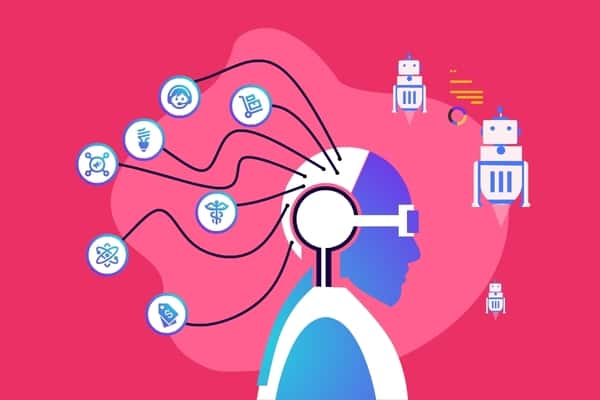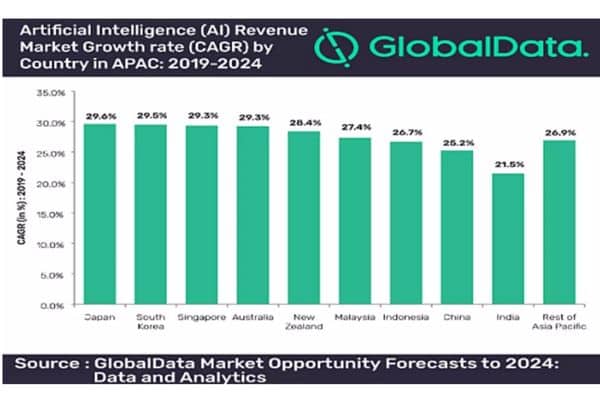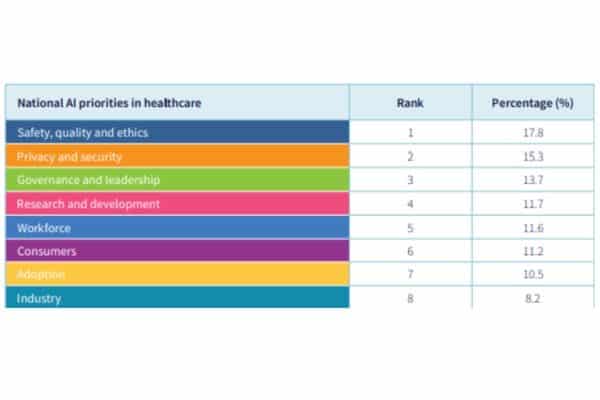
Artificial intelligence has gained quite an interest in recent years and has helped resolve many issues, especially with the COVID-19 pandemic crisis on the rise.
But how is AI being used in Australia?
In this article, we’ve assembled fascinating AI Australia statistics, so you don’t need to waste any more time searching around for fact-checked information.
Top Ten Fascinating Facts About Artificial Intelligence in Australia
- 40% of Aussie survey respondents expressed concern that AI will replace humans at work.
- 85 million workers are to be replaced by AI.
- Harrison is funded by US$117 million.
- Australia needs 161,000 more AI specialist workers by 2030.
- The Australian Government plans to invest $53.8 million in developing a National AI Centre with four other AI and Digital Capability Centres.
- In 2019, US$8.4 million were spent on IPA worldwide.
- The AI industry grew by 270% in the four years before 2019.
- Australia can save up to $1.3billion per year by using on-farm agricultural robot machines.
- In 2021, the global spending on AI cognitive systems was evaluated at US$85.3 billion.
- 42.2% of Australian AI businesses had revenue of less than $1 million in 2020.
Artificial Intelligence Usage Statistics in Australia
1. Australia’s AI market is expected to grow 29.3% by 2024.
(IT Brief)
Is Australia good for AI? Statistics show that this country is one of the leaders in the Asian Pacific in terms of Artificial Intelligence development. In 2019, Australia invested almost $30 million in AI technology and the market is expected to grow even further in the next few years by almost 30%.

2. 69.4% of survey respondents believe that AI will do more good than harm.
(Monash University)
A Monash University survey from 2020 revealed that although 89.4% of Aussie study respondents said that they are familiar with the term Artificial Intelligence, only 20.3% have a fair amount of knowledge on the subject.
Furthermore, 83.7% of survey respondents strongly agree with the notion that there should be a regulatory body that will promote Artificial Intelligence in Australia.
3. Only 22% of Australians trust AI implementation.
(IT Brief)
According to the Accenture Technology Vision 2022 report, 22% of Australian consumers and 35% worldwide trust how organisations are using AI, while more than three-quarters (82%) think companies must be held accountable for their misuse of artificial intelligence.
The data also shows that more than eight in ten Australian executives (86%) say their organisations are already dependent on AI to function effectively, and 96% say AI is becoming pervasive.
4. 40% of Aussie survey respondents expressed concern that AI will replace humans at work.
(Statista) (Computer weekly)
Statistics show that Portugal (62%) has the most people fearing losing their job to automation, with South Africa (61%) and Spain (59%) right behind. Furthermore, 40% of survey participants from Australia, France, and New Zealand all showed a negative reaction to AI development in the workforce, while people from Germany (22%) held the least apathy.
A study has found that by 2030, 63% of cubicle occupations will be automated in Australia. Knowledge diversity, on the other hand, will keep 27% of employees safe.
Due to the various skills their jobs demand, such as recognizing context and processing extremely variable inputs, Australia’s 1.2 million cross-domain knowledge workers will continue to be relevant. That is also the case in many workplaces, where good communication skills are important, even if you don’t have any previous work experience.
5. In 2020, Australia had a 2.1 AI hiring index score.
(Statista)
Although all countries had an increase in AI traffic from 2016 up to 2020, Brazil experienced the most change in the AI sector, gaining 3.4 times more AI-related career occupations. Other than Brazil, these are the countries with the biggest hiring index scores:
- India – 2.80
- Canada – 2.7
- Singapore – 2.5
- South Africa – 2.3
- Germany – 2.2
- Australia – 2.1.
6. In 2021, the global spending on AI cognitive systems was evaluated at US$85.3 billion.
(IDC)
IDC predicts growth in AI spending in the near future, jumping from $85 billion to more than $204 billion with a CAGR of 24.5%. Furthermore, it is shown that in 2021, Automated Customer Service Agents and Sales Process Recommendation and Automation were the two largest AI spending segments, accounting for US$15.9 billion of all spending that year.
7. 42.2% of Australian AI businesses had revenue of less than $1 million in 2020.
(Statista)
Between 2019 and 2020, the majority of AI businesses in Australia had a market share below US$1 million. Around 27.7% of businesses gain somewhere between $1-4.99 million, while 15.66% have a retail revenue value of $5-19.99 million. Only a small portion of 3.61% gain more than $20 million.
8. The AI industry grew by 270% in the four years before 2019.
(University of Bridgeport)
Between 2020 and 2030 career fields connected to Computer Sciences are predicted to grow at a 22% rate, after a previous growth of 270% before 2019.
9. In 2019, US$8.4 million were spent on IPA worldwide.
(Statista)
Robotic/intelligent process automation spending rates have exponentially grown in the last few years. They reached their peak in 2019 when US$2.9 million were spent on RPA and more than $8 million on IPA. It was then expected those same numbers to reach $13 million for IPA spending and $10.4 million for RPA by 2023.
AI Jobs and Popular AI Use Cases
10. The average AI salary in Australia stands at about $110,000 per year.
(PayScale)
Directors of Analytics are the highest-paid employees in the AI industry with an average of $188,000 per year. They are followed by:
- Senior Research & Development (R&D) Engineers – $180k
- Principal Data Scientist – $169k
- Senior Solutions Architect – $168k
- Lead Data Scientist – $133k
- Head of Analytics – $124k
11. 85 million workers are to be replaced by AI.
(World Economic Forum)
Analysts foresee a big change in the work industry with more than 80 million workers losing their jobs to robots and redundant jobs declining by 15.4%. However, predictions also show an even bigger number of workplaces emerging by 2025.
With around 97 million new job positions predicted, people shouldn’t need to worry that AI will completely overshadow the workforce.
12. Australia’s AI sector is expected to expand to 758,700 workers by 2023.
(University of Bridgeport) (Data 61)
To get the job Australians need to have a bachelor’s degree in computer science studies or a related field like computer engineering. Latest data reveal that 36% of the Australian workforce has a bachelor’s degree or above. However, if you want to maximise your chances of employment, you can always opt for a master’s degree in AI.
13. Harrison is funded US$117 million.
(Tracxn)
Currently, there are 773 AI startup companies in Australia. Harrison, the provider of AI systems for multiple diagnostic analysis, takes up most of the investments with US$117 million worth of funding. Willow is another exciting Australian startup company with US$81 million fundings on par with Open ($53 million).
Still when it comes to startups and funding, entrepreneurship stats from Australia reveal that most of the highly-funded companies operate in the fintech and banking industries.
We’ve listed some other AI startup companies in Australia for you to consider:
- InDebted – US$35 million
- Omniscient – US$30 million
- Emesent – US$26 million
- Huddle – US$25 million
14. AI startup companies were funded US$38 billion in the first half of 2021.
(Statista)
The amount of money invested in AI startup companies exponentially grew from 2014 to 2021. In 2019, global AI startup companies had US$26.58 billion in investments, which then increased to $36 billion in the following year.
AI Adoption Across Industries in Australiaand Globally
15. Over 80% of Aussies are interested in AI being used as a way to diagnose medical problems.
(Mindfields) (AI Health Alliance)
Safety, quality, and ethics are the top priority for 17.8% of Australians regarding AI usage in the healthcare system. Additionally, they stated their need for privacy (15.3% of consumers are concerned if AI protects their private information), leadership (13.7%), and research and development (11.7%).

16. Microsoft invested $25 million in a 5-year AI for an Accessibility program.
(Data 61)
Around 18% of Aussies live with a disability. Luckily, Microsoft provides an AI Accessibility program made to help these people with daily tasks. Vision impaired people can use the Soundscape app to receive audio prompts about places and objects around them. Furthermore, the Endeavour Foundation made accessible 15 learning programs for people with mental disabilities.
17. Western Australia has 112 Fortesque driverless trucks that help with mining operations.
(Data 61)
The Pilbara region is already heavily reliant on AI equipment for mining purposes. For example, the Rio Tinto mine-of-the-future is the most automated one with 140 driverless trucks, 60% of train kilometres in autonomous mode, and over 11 automated drills. On the other hand, BHP has 50 autonomous vehicles and 20 autonomous drills.
18. Australia can save up to $1.3 billion per year by using on-farm agricultural robot machines.
(Data 61)
Because some weeds have become resistant to herbicides, the Queensland University of Technology developed the Agron II robot which sprays and mechanically destroys unwanted weeds, thus improving the overall farming productivity.
19. AI has a 21% usage rate in service operations and product development.
(Statista)
AI technology is used in service operations (21%) and product development (21%) at a large rate to further help the industry. This is how much Artificial Intelligence has impacted all the other industry functions worldwide:
- Marketing and sales – 15%
- Manufacturing – 12%
- Risk – 10%
- Supply chain management – 9%
- Human resources – 8%
- Strategy and corporate finances – 7%
20. AI has a 39% usage rate in high tech service operations.
(Statista)
The telecom industry has the biggest AI usage rate out of all the industries worldwide, especially in the functions related to service operations (39%) and product development (37%). Marketing and sales functions are right up next with a 26% rate, followed by human resources (14%), risk (14%), supply chain management (12%), manufacturing (11%), and strategy and corporate finance (9%).
21. 58% of respondents think that AI algorithms are best used for fraud detection in financial services.
(Statista)
Most survey respondents state that financial services might find AI most useful for fraud detection and finance process and analysis (41%). Cybersecurity (33%) is another valuable AI use case, on par with the personalization of products and services (33%). Customer care and asset maintenance have a share of 31% and 25%, respectively.
22. Almost 60% of survey respondents state that AI assistance is mostly needed for quality control in the manufacturing industry.
(Statista)
Other than quality control, inventory management (44%) seems to be the most important AI use case for the manufacturing industry, according to online survey respondents. They are followed by:
- Monitoring diagnostics – 32%
- Customer care – 29%
- Personalization of products and services – 22%
- Asset maintenance – 22%.
23. Aerospace, defence, and security is the most AI serviced industry in Australia with a 50.6% share.
(Statista)
More than half of AI organisations participating in an online survey stated that Artificial Intelligence is mostly needed in the aerospace, defence, and security industry. It is followed by:
- Mining, energy and resources – 43.4%
- Agriculture – 33.7%
- Healthcare – 33.7%
- Transport – 32.5%
- Information technology services – 30.1%
- Financial services – 26.5%
- Logistics – 26.5%
- Retail – 25.3%.
AI Technology, Trends & Drivers
24. The Australian Government plans to invest $53.8 million in developing a National AI Centre with four other AI and Digital Capability Centres.
(Australian Government)
Australia wants to establish a National AI Centre in order to increase business adoption of AI technology through coordination of AI activity, expertise and capabilities. The Australian Government will also provide $12 million to the Catalysing the AI Opportunity in our Regions program,which will co-fund competitive grants to spread AI benefits all across Australia.
25. The Australian Government invested $1.5 billion in a Modern Manufacturing Strategy.
(Australian Government)
With the Modern Manufacturing Strategy, Australia plans to help businesses increase the usage of technology. The Digital Solutions – Australian Small Business Advisory Services $12.7 million investment will make sure digital technologies are accessible to 17,000 small businesses in Australia. Additionally, Australia’s AI action plan also includes a Digital Business-to-Business (B2B) Partnerships Initiative and a Digital Foundations for Agriculture Strategy.
26. Australia needs up to 161,000 AI specialist workers by 2030.
(Data 61)
Are AI jobs in demand in Australia? In 2019, Australia’s IT sector gained a revenue of $122 billion by employing 580,000 workers. As the industry keeps on expanding, CSIRO foresees that by 2030, the specialist AI workforce will need somewhere between 32,000 – 161,000 more workers.
Bottom Line
Artificial intelligence has helped people immensely with virtual assistants, spam filtering, image labelling, and even facial recognition. Because of its huge influence, the Australian government is planning on implementing certain strategies that will help the AI Australia industry reach a wider audience and transform industries and businesses for the better.
Sources:
- AI Health Alliance
- Australian Government
- Computer Weekly
- Data 61
- IDC
- IT Brief
- IT Brief
- Mindfields
- Monash University
- PayScale
- Statista
- Statista
- Statista
- Statista
- Statista
- Statista
- Statista
- Statista
- Statista
- Tracxn
- University of Bridgeport
- World Economic Forum
Source – https://takeatumble.com.au/technologies/ai-australia/
